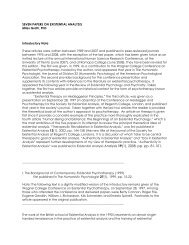The Sonate auf Concertenart: A Postmodern Invention? David ...
The Sonate auf Concertenart: A Postmodern Invention? David ...
The Sonate auf Concertenart: A Postmodern Invention? David ...
You also want an ePaper? Increase the reach of your titles
YUMPU automatically turns print PDFs into web optimized ePapers that Google loves.
<strong>Sonate</strong> <strong>auf</strong> <strong>Concertenart</strong>, p. 25<br />
73 m. 8b. <strong>The</strong> eventual restatment of a sequential passage from the ritornello, in mm. 61-2, thus has<br />
no clear articulatory significance. It confirms the return to the tonic key area that has occurred by<br />
this point, but it carries none of the force of of a closing ritornello or "tutti" passage in a solo<br />
concerto.<br />
More fundamental than the supposed "tutti" or "solo" character of any instrumental part<br />
may be the mere presence of some sort of contrast between the types of material associated with<br />
each of the upper parts, at least in their initial entries. Thus, as Swack has observed, in the Amajor<br />
sonata BWV 1032 (ex. 2) the flute enters with a contrasting lyrical theme, and nowhere in<br />
the surviving fragment does this part play the virtuoso passagework characteristic of the mature<br />
74<br />
solo concerto. That this was a normal procedure emerges from such instances as the Graun<br />
sonata (ex. 1), in which the flute entrance is marked Cantabile, and from the first movements of<br />
75<br />
the doubtful sonatas for flute and keyboard BWV 1020 and 1031. In some works, such as the<br />
Graun sonata in A (ex. 1), the original dichotomy between the two melody instruments is retained<br />
throughout the movement; the violin never plays the flute's new theme, and the flute plays only<br />
material from the later portions of the violin's opening (ritornello) passage. Bach allows a greater<br />
amount of interplay in most such movements, but in the extant portion of BWV 1032/1, as in<br />
Wendt 8, the harpsichord never plays the flute's opening gesture.<br />
This, incidentally, creates a dilemma for reconstructers of the missing portion of the Bach<br />
movement: whether or not to transfer the flute's opening line to the keyboard at some point, in<br />
keeping with Bach's usual practice of exchanging significant thematic material between the<br />
76<br />
principal parts. Giving the keyboard a solo statement of the flute's opening line, in emulation of<br />
73 Cf. Williams (<strong>The</strong> Organ Music, 15): in the first movement of BWV 526, "sections<br />
could follow each other in various orders"; he cites the instance in which "the passage built on<br />
sequential trills" leads first to passage "B" (m. 22) and later to "A" (mm. 70-1).<br />
74<br />
Swack, "On the Origins," 404-5.<br />
75<br />
Other examples occur in Telemann's quartet sonatas or concertos TWV 43:g2, 43:G12,<br />
and 43:A4. Mary Oleskiewicz, "Quantz and the Flute at Dresden: His Instruments, His Repertory,<br />
and <strong>The</strong>ir Significance for the Versuch and the Bach Circle" (Ph.D. diss., Duke University, 1998),<br />
245, finds that in about a quarter of Quantz's concerto movements the flute enters with material<br />
"more lyrical than the ritornello"--but the solo episodes of quick movements usually still proceed<br />
to virtuoso writing.<br />
76<br />
For a survey of some of the numerous reconstructions of BWV 1032, see Gerhard<br />
Kirchner, "Ein Schnitt und seine Folgen: Zum ersten Satz der <strong>Sonate</strong> BWV 1032," in Festschrift<br />
Hans-Peter Schmitz zum 75. Geburtstag, ed. Andreas Eichhorn (Kassel: Bärenreiter, 1992),<br />
117-34. I am grateful to Walter Mayhall for bringing this article to my attention. Marissen<br />
describes his own reconstruction (unknown to Kirchner) in "A Critical Reappraisal." In my<br />
unpublished version--which is similar in broad outlines to that described by Marissen--the passage<br />
first heard in mm. 9-33 is recapitulated a fifth lower and with the upper parts exchanged to<br />
conclude the movement.















